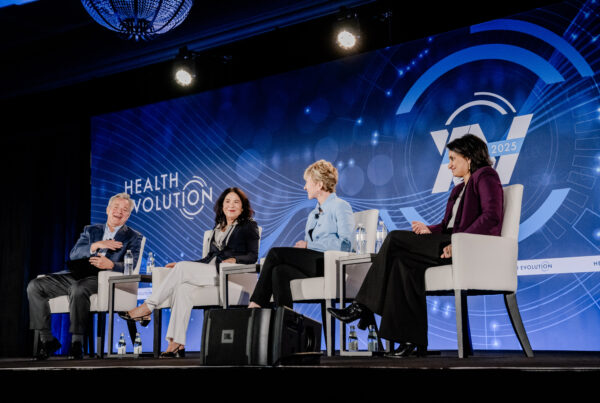Should health care organizations leverage social media and smartphones in new ways to address the mental health crisis among America’s youth?
Tom Insel, former Director of the National Institute of Mental Health, posed that question during a Main Stage discussion, The Kids Aren’t All Right: Charting a Path Forward for Pediatric Mental Health, that also included Rhonda Robinson Beale, MD, SVP & Deputy Chief Medical Officer, Mental Health Services, UnitedHealth Group, Josh Golomb, CEO, Hazel Health and R. Lawrence Moss, MD, President & CEO, Nemours Children’s Health.
“How do we meet kids where they are? Adolescents aren’t looking to meet us where we are. They are online,” Insel said. “If we’re really trying to make a difference here and trying to address this crisis, we need to find new ways to do that.”
Social media and harm to mental health
It’s no secret at this point that the growing use of smartphones and social media have been connected to increases in mental distress, self-harm and other behavioral issues.
“We started seeing a steady increase in anxiety and depression as the adoption and the percent of ownership of smartphones and social media, particularly among adolescents and young adults, correlate so well,” Beale said.
Read all of our 2022 Summit articles
When she talks to providers delivering emergency or inpatient care, many tell her that pressure on social media is one of the most prominent factors driving kids to suicidal ideation, cutting and other adverse behaviors.
“I’d really love to change the narrative, the finger pointing and this attempt to say there is a singular cause for this problem,” Insel said. “We should be thinking more creatively because if social media is where the kids are, and if engagement is one of the biggest barriers to mental health care, then we’re missing an opportunity by just blaming the tech companies.”
What’s more, the shortage of mental health professionals and projected growth in demand for behavioral health services suggest the problem will only become worse.
The mental health care crisis is a social problem
Looking at China because COVID emerged there before the U.S., Beale said that data shows impacts on mental health emerge well after the initial outbreak.
“In China, six months after COVID the symptoms of anxiety, depression and PTSD all went up. The data indicated that even after the pandemic we’re likely to see a continuous increase in the U.S. where we have already seen a tremendous increase in access to behavioral health services,” Beale said.
Golomb added that recent data from the Kennedy Forum found that more than half of adults in the last two years had sought professional mental health care services for their children.
“We’re making a big mistake if we just medicalize this problem because if we don’t get at the root of it, we can’t possibly build enough beds or train enough providers or do enough workforce interventions,” Moss said. “It’s a social problem.”
Insel agreed that while mental health can be defined as medical problem, the solutions must be more relational, environmental, social, even political in nature for the U.S. to move upstream toward prevention and early diagnosis.
Tech can enable fundamental connections
While it’s easy to vilify technology and social media, Moss was careful to avoid such mischaracterizations and, instead, said that it’s more productive to consider technology as a tool that can be part of the overall solution.
“I will give a bit of a Buddhist take. Technology is not good. Technology is not bad. Technology is,” Moss said. “We take our eye off the ball when we start to worry about whether it’s good or bad or hurting our kids. It is our reality and it’s not going away. So it’s our job to figure out how to harness technology and use it to get through this mental health crisis.”
Golomb noted that smartphones and social media, when used effectively, can both reach kids where they are and, equally important, match a child with the most appropriate type of provider because not everyone needs a child psychiatrist, psychologist or even therapist every time they seek help. Beale added that in her experience, which includes nearly two decades of running a capitated practice for behavioral health, the fundamental need most people have is a connection to someone.
“If you’re able to give that connection right away in a genuine caring manner, you decrease the amount of people who end up in ERs and hospitalizations,” Beale said.
Beale added that from a public health perspective, the U.S. has a responsibility to look at ways to support children as they’re growing up and to build the skills necessary to be resilient and emotionally strong in the face of all kinds of situations, trauma, climate change, social injustice and other challenges that kids are not necessarily prepared for.
“It’s incumbent upon us to get the tech companies engaged and to be a part of the solution,” Golomb said.
Canary in the coal mine?
No one is saying that either persuading technology and social media companies to take an active role in addressing youth mental health or determining ways to use their platforms to that end without their cooperation will be easy.
The same negative conditions that exist today, cyberbullying, the ability to be cruel due to the lack of a face-to-face interaction and others, will persist. As will the need to understand and designate what information or services are helpful and supportive and which are harmful or simply a waste of time.
“I don’t think it’s easy. It’s a huge challenge, but it speaks to the public health need to do this,” Beale said.
Insel said that in order to move beyond the crisis, CEOs and experts need to frame and describe the problem in a more holistic way so the industry can shift toward prevention — and there is a sense of urgency for changing.
“In some ways this crisis is the canary in the coal mine for a whole generation, which may be the COVID generation,” Insel said. “The mental health crisis may be a defining feature of how they develop and grow up. And the hope is that they’ll build resilience from this.”











